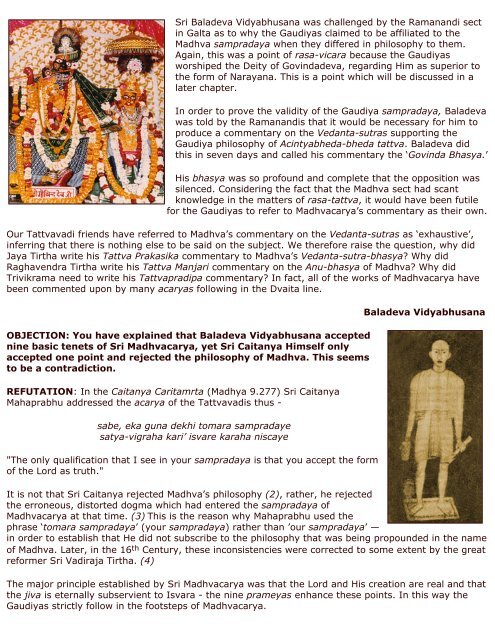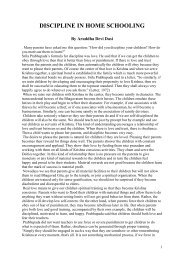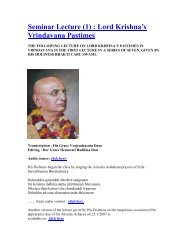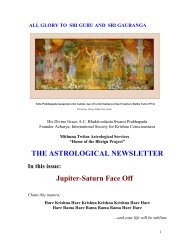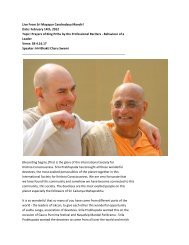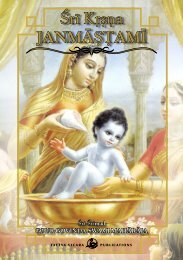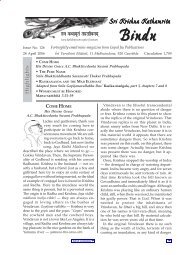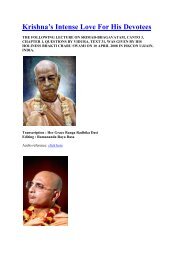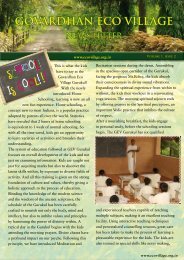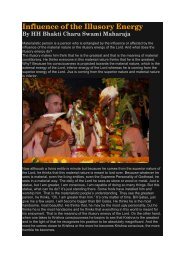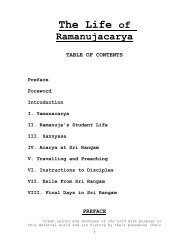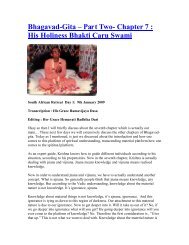Gaudiya siddhanta - ebooks - ISKCON desire tree
Gaudiya siddhanta - ebooks - ISKCON desire tree
Gaudiya siddhanta - ebooks - ISKCON desire tree
You also want an ePaper? Increase the reach of your titles
YUMPU automatically turns print PDFs into web optimized ePapers that Google loves.
Sri Baladeva Vidyabhusana was challenged by the Ramanandi sect<br />
in Galta as to why the <strong>Gaudiya</strong>s claimed to be affiliated to the<br />
Madhva sampradaya when they differed in philosophy to them.<br />
Again, this was a point of rasa-vicara because the <strong>Gaudiya</strong>s<br />
worshiped the Deity of Govindadeva, regarding Him as superior to<br />
the form of Narayana. This is a point which will be discussed in a<br />
later chapter.<br />
In order to prove the validity of the <strong>Gaudiya</strong> sampradaya, Baladeva<br />
was told by the Ramanandis that it would be necessary for him to<br />
produce a commentary on the Vedanta-sutras supporting the<br />
<strong>Gaudiya</strong> philosophy of Acintyabheda-bheda tattva. Baladeva did<br />
this in seven days and called his commentary the ‘Govinda Bhasya.’<br />
His bhasya was so profound and complete that the opposition was<br />
silenced. Considering the fact that the Madhva sect had scant<br />
knowledge in the matters of rasa-tattva, it would have been futile<br />
for the <strong>Gaudiya</strong>s to refer to Madhvacarya’s commentary as their own.<br />
Our Tattvavadi friends have referred to Madhva’s commentary on the Vedanta-sutras as ‘exhaustive’,<br />
inferring that there is nothing else to be said on the subject. We therefore raise the question, why did<br />
Jaya Tirtha write his Tattva Prakasika commentary to Madhva’s Vedanta-sutra-bhasya? Why did<br />
Raghavendra Tirtha write his Tattva Manjari commentary on the Anu-bhasya of Madhva? Why did<br />
Trivikrama need to write his Tattvapradipa commentary? In fact, all of the works of Madhvacarya have<br />
been commented upon by many acaryas following in the Dvaita line.<br />
OBJECTION: You have explained that Baladeva Vidyabhusana accepted<br />
nine basic tenets of Sri Madhvacarya, yet Sri Caitanya Himself only<br />
accepted one point and rejected the philosophy of Madhva. This seems<br />
to be a contradiction.<br />
REFUTATION: In the Caitanya Caritamrta (Madhya 9.277) Sri Caitanya<br />
Mahaprabhu addressed the acarya of the Tattvavadis thus -<br />
sabe, eka guna dekhi tomara sampradaye<br />
satya-vigraha kari’ isvare karaha niscaye<br />
"The only qualification that I see in your sampradaya is that you accept the form<br />
of the Lord as truth."<br />
Baladeva Vidyabhusana<br />
It is not that Sri Caitanya rejected Madhva’s philosophy (2), rather, he rejected<br />
the erroneous, distorted dogma which had entered the sampradaya of<br />
Madhvacarya at that time. (3) This is the reason why Mahaprabhu used the<br />
phrase ‘tomara sampradaya’ (your sampradaya) rather than ’our sampradaya’ —<br />
in order to establish that He did not subscribe to the philosophy that was being propounded in the name<br />
of Madhva. Later, in the 16 th Century, these inconsistencies were corrected to some extent by the great<br />
reformer Sri Vadiraja Tirtha. (4)<br />
The major principle established by Sri Madhvacarya was that the Lord and His creation are real and that<br />
the jiva is eternally subservient to Isvara - the nine prameyas enhance these points. In this way the<br />
<strong>Gaudiya</strong>s strictly follow in the footsteps of Madhvacarya.


